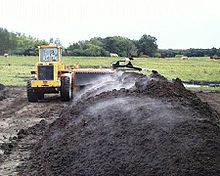User:WhisenRosei/Concentrated animal feeding operation
| This is the sandbox page where you will draft your initial Wikipedia contribution.
If you're starting a new article, you can develop it here until it's ready to go live. If you're working on improvements to an existing article, copy only one section at a time of the article to this sandbox to work on, and be sure to use an edit summary linking to the article you copied from. Do not copy over the entire article. You can find additional instructions here. Remember to save your work regularly using the "Publish page" button. (It just means 'save'; it will still be in the sandbox.) You can add bold formatting to your additions to differentiate them from existing content. |
Negative production externalities[edit | edit source]
[edit]Some argue[by whom?] that CAFOs have unfair advantages due to their ability to shift the costs of animal waste externally like this cattle manure.
Critics have long argued[by whom?] that the "retail prices of industrial meat, dairy, and egg products omit immense impacts on human health, the environment, and other shared public assets." The negative production externalities of CAFOs have been described as including "massive waste amounts with the potential to heat up the atmosphere, foul fisheries, pollute drinking water, spread disease, contaminate soils, and damage recreational areas" that are not reflected in the price of the meat product. Environmentalists contend that "citizens ultimately foot the bill with hundreds of billions of dollars in taxpayer subsidies, medical expenses, insurance premiums, declining property values, and mounting cleanup costs." Some economists agree that CAFOs "operate on an inefficient scale." It has been argued, for instance, that "diminishing returns to scale quickly lead to costs of animal confinement that overwhelm any benefits of CAFOs." These economists claim that CAFOs are at an unfair competitive advantage because they shift the costs of animal waste from CAFOs to the surrounding region (an unaccounted for "externality").
CAFOs may contribute to a drop in nearby property values. Reasons for this decrease in property values include: potential risk of water contamination, odors, air pollution, and other health related issues. One study shows that property values on average decrease by 6.6% within a 3-mile (4.8 km) radius of a CAFO and by 88% within 1/10 of a mile from a CAFO. Proponents of CAFOs, including those in farm industry, respond by arguing that the negative externalities of CAFOs are limited. One executive in the pork industry, for instance, claims that any odor or noise from CAFOs is limited to an area within a quarter-mile of the facility. Proponents also point to the positive effect they believe CAFOs have on the local economy and tax base. CAFOs buy feed from and provide fertilizer to local farmers. And the same executive claims that farmers near CAFOs can save $20 per acre by using waste from CAFOs as a fertilizer.
Environmentalists contend that "sustainable livestock operations" present a "less costly alternative." These operations, it is argued, "address potential health and environmental impacts through their production methods." And though "sustainably produced foods may cost a bit more, many of their potential beneficial environmental and social impacts are already included in the price." In other words, it is argued that if CAFO operators were required to internalize the full costs of production, then some CAFOs might be less efficient than the smaller farms they replace.
Negative production externalities
[edit]
The price of meat does not reflect the the negative ecological impacts that result from industrial agricultural systems. [1][2] The negative production externalities (when market prices inappropriately reflect or hide the societal harms incurred in the creation of a product[3]) of CAFOs include damaging effects to the environment caused by, among others, ever-increasing amounts of often poorly managed waste.[4] The costs from damage caused to the atmosphere (in the form of GHGs), water, soil, fisheries, and recreational areas, estimated at hundreds of billions of dollars, are typically not incurred by corporations that feature the use of CAFOs in their business models.[4] Additionally, human antimicrobial resistance from antibiotic use in industrial animal agriculture represents a serious risk to societal wellbeing.[3] Corporations that rely on using CAFOs through contract farming have an unfair economic advantage because the costs of managing animal waste is shifted to contract farmers and, when spills occur, to the areas surrounding them.[5] Property values near CAFOs may plummet considerably due to the detrimental impacts that CAFOs can have on air, water, and land in the nearby areas.[5][6] For instance, researchers found that there is a statistically significant relationship between property values declines and CAFO proximity. [7]
- ^ Pieper, Maximilian; Michalke, Amelie; Gaugler, Tobias (2020-12-15). "Calculation of external climate costs for food highlights inadequate pricing of animal products". Nature Communications. 11 (1): 6117. doi:10.1038/s41467-020-19474-6. ISSN 2041-1723. PMC 7738510. PMID 33323933.
{{cite journal}}: CS1 maint: PMC format (link) - ^ Logan, Cloe (2020-12-24). "Should the price of meat reflect its impact on the environment?". Canada's National Observer. Retrieved 2023-04-27.
- ^ a b Innes, Gabriel K.; Randad, Pranay R.; Korinek, Anton; Davis, Meghan F.; Price, Lance B.; So, Anthony D.; Heaney, Christopher D. (2020-04-02). "External Societal Costs of Antimicrobial Resistance in Humans Attributable to Antimicrobial Use in Livestock". Annual Review of Public Health. 41 (1): 141–157. doi:10.1146/annurev-publhealth-040218-043954. ISSN 0163-7525. PMC 7199423. PMID 31910712.
{{cite journal}}: CS1 maint: PMC format (link) - ^ a b Imhoff, Daniel; Tompkins, Douglas; Carra, Roberto (2010). CAFO: The Tragedy of Industrial Animal Factories. Devon, UK: Earth Aware Editions/NHBS. ISBN 9781601090584.
- ^ a b Moore, Robin (2018-04-14). Principles of Animal Nutrition. Scientific e-Resources. ISBN 978-1-83947-447-7.
- ^ Isakson, Hans R.; Ecker, Mark D. (2008-10-23). "An analysis of the impact of swine CAFOs on the value of nearby houses". Agricultural Economics. 39 (3): 365–372. doi:10.1111/j.1574-0862.2008.00339.x.
- ^ Herriges, Joseph A.; Secchi, Silvia; Babcock, Bruce A. (2005-11-01). "Living with Hogs in Iowa: The Impact of Livestock Facilities on Rural Residential Property Values". Land Economics. 81 (4): 530–545. doi:10.3368/le.81.4.530. ISSN 0023-7639.
